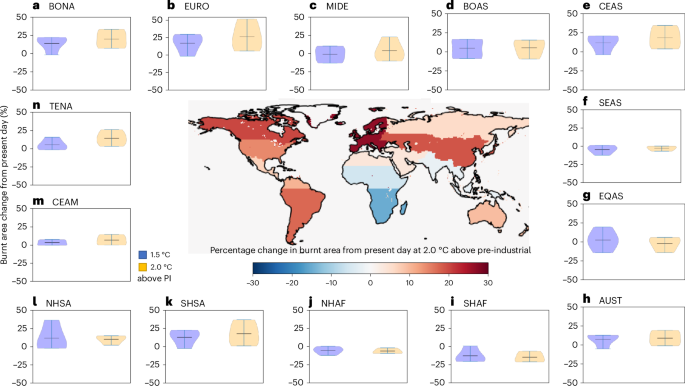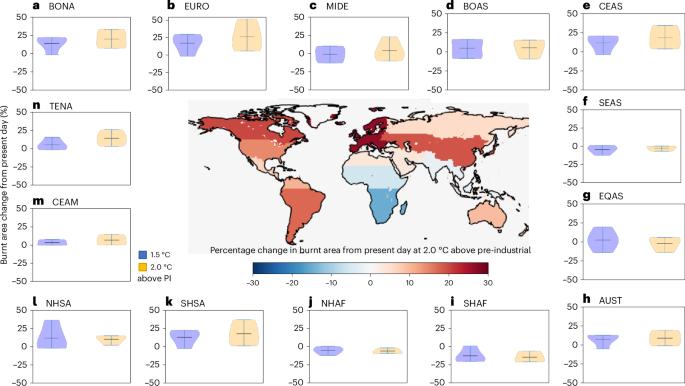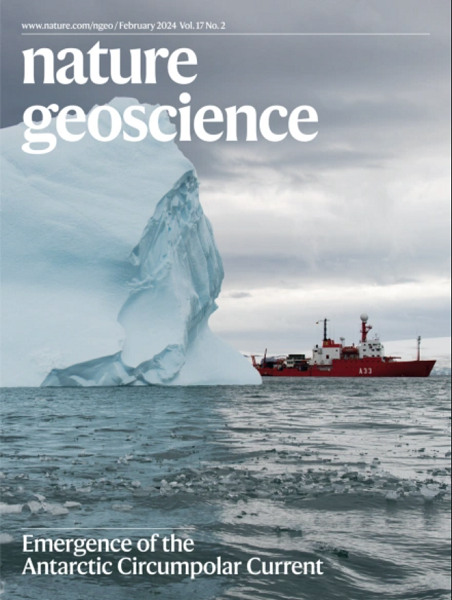火灾削弱了 1.5 °C 前的陆地碳汇
IF 15.7
1区 地球科学
Q1 GEOSCIENCES, MULTIDISCIPLINARY
引用次数: 0
摘要
为避免气候变化带来的最坏影响,《巴黎协定》承诺各国通过紧急减少温室气体排放,努力将全球升温控制在 1.5 ℃以内。然而,《巴黎协定》的气温目标和剩余碳预算所使用的模型大多缺乏火灾、植被和碳之间的反馈,而这对于了解生态系统未来的恢复能力至关重要。在此,我们使用火灾-植被耦合模型来探讨全球变暖水平对区域的影响和反馈。我们探讨了 1.5 °C 的目标是否符合在考虑火灾机制变化时避免生态系统发生重大变化的要求。我们发现,火灾开始对全球碳储存产生重大影响的全球变暖水平是比工业化前水平高 1.07 ℃(0.8-1.34 ℃),并得出结论:火灾已经在降低陆地碳汇的有效性方面发挥了重要作用。我们估计,与之前的估计相比,如果将温度上升限制在 1.5 ℃,火灾会使剩余的碳预算减少 25 Gt CO2(~5%);如果将温度上升限制在 2.0 ℃,火灾会使剩余的碳预算减少 64 GtCO2(~5%)。尽管将升温限制在 1.5 °C对于避免气候变化的最坏影响仍然至关重要,但在许多情况下,我们已经到了富含碳和生物多样性的生态系统发生重大变化的地步。本文章由计算机程序翻译,如有差异,请以英文原文为准。


Fire weakens land carbon sinks before 1.5 °C
To avoid the worst impacts of climate change, the Paris Agreement committed countries to pursue efforts to limit global warming to 1.5 °C by urgently reducing greenhouse gas emissions. However, the Paris temperature ambitions and remaining carbon budgets mostly use models that lack feedback among fire, vegetation and carbon, which are essential for understanding the future resilience of ecosystems. Here we use a coupled fire–vegetation model to explore regional impacts and feedbacks across global warming levels. We address whether the 1.5 °C goal is consistent with avoiding significant ecosystem changes when considering shifts in fire regimes. We find that the global warming level at which fire began to impact global carbon storage significantly was 1.07 °C (0.8–1.34 °C) above pre-industrial levels and conclude that fire is already playing a major role in decreasing the effectiveness of land carbon sinks. We estimate that considering fire reduces the remaining carbon budget by 25 Gt CO2 (~5%) for limiting temperature rise to 1.5 °C and 64 GtCO2 (~5%) for 2.0 °C compared to previous estimates. Whereas limiting warming to 1.5 °C is still essential for avoiding the worst impacts of climate change, in many cases, we are already reaching the point of significant change in ecosystems rich in carbon and biodiversity. Only about 1.07 °C of climate warming above the pre-industrial level is required for fire to substantially diminish the effectiveness of global carbon sinks, suggesting that climate change has already been weakening carbon storage through fire, according to integrated model simulations that consider the interaction between fire and vegetation.
求助全文
通过发布文献求助,成功后即可免费获取论文全文。
去求助
来源期刊

Nature Geoscience
地学-地球科学综合
CiteScore
26.70
自引率
1.60%
发文量
187
审稿时长
3.3 months
期刊介绍:
Nature Geoscience is a monthly interdisciplinary journal that gathers top-tier research spanning Earth Sciences and related fields.
The journal covers all geoscience disciplines, including fieldwork, modeling, and theoretical studies.
Topics include atmospheric science, biogeochemistry, climate science, geobiology, geochemistry, geoinformatics, remote sensing, geology, geomagnetism, paleomagnetism, geomorphology, geophysics, glaciology, hydrology, limnology, mineralogy, oceanography, paleontology, paleoclimatology, paleoceanography, petrology, planetary science, seismology, space physics, tectonics, and volcanology.
Nature Geoscience upholds its commitment to publishing significant, high-quality Earth Sciences research through fair, rapid, and rigorous peer review, overseen by a team of full-time professional editors.
 求助内容:
求助内容: 应助结果提醒方式:
应助结果提醒方式:


